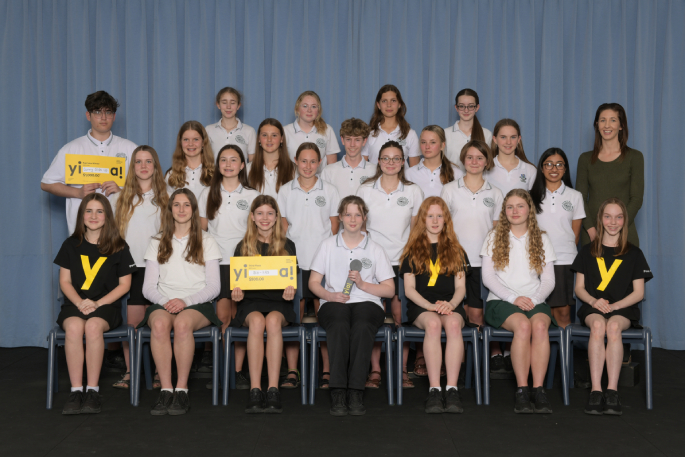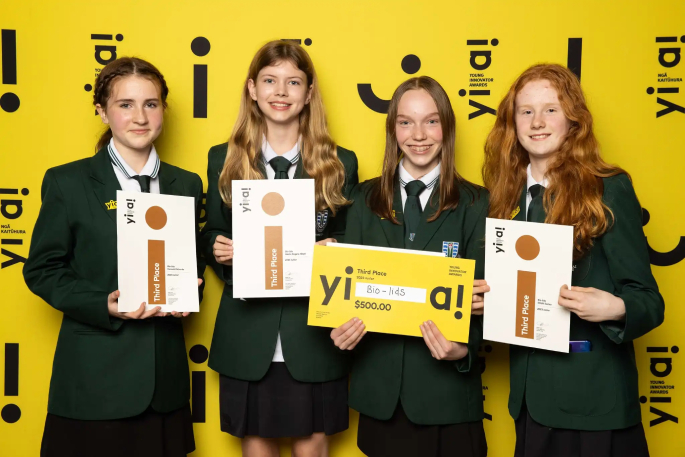“Our problem is light pollution,” says Shorter and Hex team member Amelia Shorter. “Light pollution is the presence of unwanted or excessive artificial light.”
She is talking about what prompted her and her fellow team member Haylee Hextall to come up with an innovative idea for the Young Innovator Awards – also known as yia!.
Their solution to this problem has won the Otumoetai College Year 12 students the Supreme Award in the yia! Seniors category with their innovation Glowshield. As well as prize money of $2000, they go on to receive valuable internship experience with some of the BOP’s top innovative businesses.
“It’s a growing problem here in New Zealand, as you can see with the port lights from the summit of Mauao at night,” says Haylee.
They also point out that residential streets and urban areas are producing light pollution, and how it impacts on wildlife.
“Light pollution affects birds, because they get stunned by the bright lights and crash due to confusion,” says Amelia.
“Light pollution also affects birds by disrupting their circadian rhythm, causing them to migrate or breed in the wrong season.
“So we created Glowshield.”
Glowshield works by placing a shield around the light, directly concentrating light from street lamps onto the road below. A second red shield acts as a barrier for excess light. Light that travels upwards through this barrier is dimmed and tinted red “which is a less harmful colour for birds”.
Young Innovator Awards
The Young Innovator Awards is an awards programme for school students in the Western Bay of Plenty aged nine to 18 years old, with a vision to create innovators.
The students, who can enter individually or as a team of up to five students, come up with an idea for an innovative product or service. If the panel of NZ innovation legends judge theirs to be the best, the winner will receive “oodles of cash, a money can’t buy yia! Internship and look like a bit of a genius in front of their mates”.
 The Otumoetai College students who were involved in yia! this year, with teacher Kristy Lance. Photo: Supplied.
The Otumoetai College students who were involved in yia! this year, with teacher Kristy Lance. Photo: Supplied.
Otumoetai College Head of IT Services Ros Lee says yia!, which has been running since 2010, is a fantastic initiative.
“For me it's a perfect example of the many fantastic initiatives happening each year regionally and nationally that our students can take part in beyond the classroom," says Ros.
"These require enormous commitment from students and staff as well as the goodwill of many individuals in the community who donate their time, money and expertise in sponsorship and mentorship.
“Real life problem solving is becoming more important in education.”
Ros is also rapt about the stunning results for Otumoetai College.
“Our school won the Junior and the Senior Supreme awards, the Sustainability Award and the Research Award. And the third-place award in the Junior category.”
P-PECK – Sunny side up
Team P-PECK, made up of students Peyton Clode, Pauline Beetz, Emma Hurley, Kale Brooking and Catelyn Evans created ‘Sunny side up’, taking out first prize in the Junior Supreme awards.
They receive $1000 and valuable internship experience with some of the BOP’s top innovative businesses.
 Team P-PECK. Photo: Supplied.
Team P-PECK. Photo: Supplied.
“Our solution for high egg prices, food waste, lack of nearby volunteering opportunities and battery farming is a community chicken farm.
“We created a system to connect people who had food waste to chickens that need food. In exchange for their food waste, people will receive eggs.
“This will function through an app with two main features. The first feature is for volunteers who want to register.
“Once those who want to have applied, they will be judged based on their capability and space to see if they can keep a coop of chickens.
“If approved they will receive their coop, chickens included."
The second feature of the app is an interactive map showing where the coops are, how much food they need each day, and how many chickens are at each coop location.
“Chickens are required to be fed twice a day, so the app will highlight the coop in need of a meal and once they’re given food, their hungry icon will disappear.
“Using our innovation, we can reduce the 122,547 tonnes of food waste in New Zealand per year, hinder the need of international battery farms, and offer a cheap alternative to the expensive eggs in supermarkets.
KEAH – Bio-lids
Team KEAH with Katy McLeod, Elliott Swney, Alexia Rogers-Hibell and Hannah Richards won third prize of $500 in the Juniors’ category, for their innovation Bio-lids. They also won the Sustainability Award.
Bio-lids are biodegradable milk bottle lids, created to help solve plastic pollution.
 Team KEAH. Photo: Supplied.
Team KEAH. Photo: Supplied.
Plastic bottle lids are one of the top five pollutants of the ocean. With 100 million animals dying from plastic pollution and at least 14 million tonnes of plastic entering the ocean yearly this is a major issue.
“Our lids are made from cellulose nanofibers that have been sourced from native New Zealand seaweed.
“They help with pollution by stopping the problem at its source.”
The team say that this means that before the bottle lids find their way to the ocean, they are able to biodegrade in soil.
“Regular bottle lids can take up to 500 years, whereas our milk bottle lids will decompose within a year.
“The large misconception on whether milk bottle lids can be recycled in New Zealand has left citizens extremely confused. This has resulted in the lids being recycled when they shouldn’t.
“With our invention, we will be able to save the lives of millions of sea life. We hope that in the future, our design will be used in future ideas.”
Solution Seaweed
As mentioned previously, in the seniors section, Shorter and Hex took out the Supreme Award in the senior category.
Also in the seniors section, team Solution Seaweed, made up of Charlie Minshall and Kara Blackstock won the Research Award for their innovation ‘Solution seaweed’.
 Kara Blackstock, who along with Charlie Minshall, won the Research Award. Photo: Supplied.
Kara Blackstock, who along with Charlie Minshall, won the Research Award. Photo: Supplied.
“Once we found out that the ocean’s acidity levels have increased by 30 per cent since 1840, we knew we had to make a change,” says Charlie.
“No matter our age,” says Kara.
“Our innovation looks to decrease our ocean acidification levels while increasing bio-diversity, generating lots of new eco-systems,” says Charlie.
“And it can even create a sustainable bio-fuel that can revolutionize our world. Let’s eco-engineer our future and protect our precious New Zealand wildlife from this ocean acidification.”
For Otumoetai College teacher-in-charge Kristy Lance, it’s her first year as the college’s facilitator.
“I admire hugely the students and teachers who do these extra things,” says Kristy.
“I thought the innovations were incredible. They’ve solved real issues that we all experience on a day-to-day basis, and came up with solutions that as adults we may not consider.
“They go thru the design thinking process as part of YIA which is a great process. And we facilitate the space for them to have a chance to explore their ideas.”
“I think it’s a great initiative.”



0 comments
Leave a Comment
You must be logged in to make a comment.